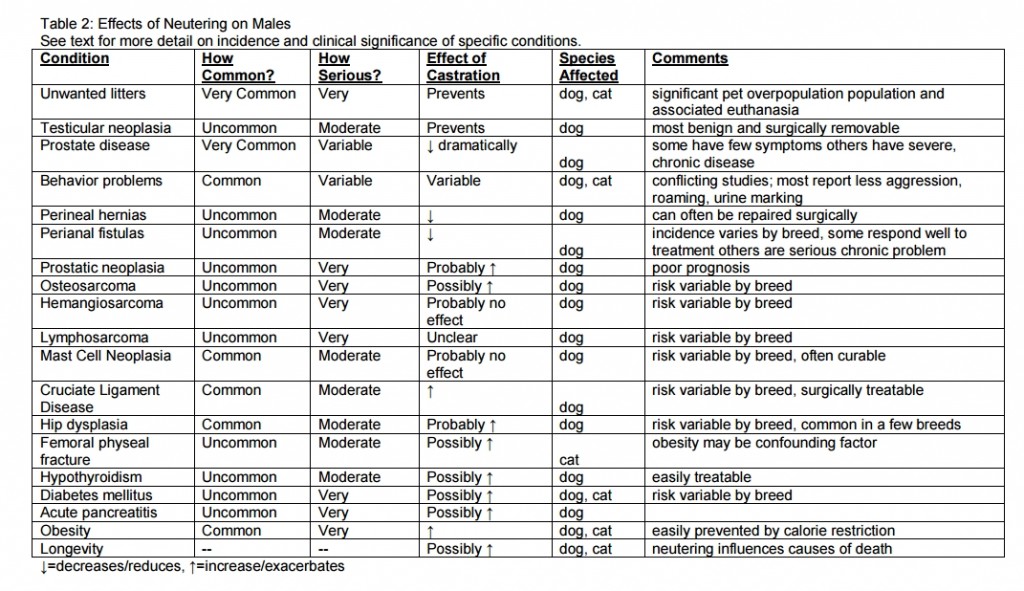As Neutering and Spaying still is a hot topic in the world of animal protection and we also reported on current scientific developments, we asked the major animal protection services in the USA to give us their opinion on why they don’t consider vasectomy and tubal ligation as an alternative to spay and Neutering.
The quickest answer came from PETA with an astonishing question to answer time of 20 minutes!
“We support neutering as the better option. Vasectomies leave reproductive urges intact, while neutering greatly diminishes and possibly eliminates them. Dogs who have been neutered are far less likely to roam far from home or fight. Additionally, they are protected from testicular cancer and run less risk of contracting prostate disease.”
According to the recent scientific Articles behavioral changes due to neutering/spaying differs from case to case. The outcome and impact of neutering/spaying can not be determinded beforehand. The reproductive urges are not determined by the gonads, but by the brain itself. Yes, hormones have an impact on the urges, BUT they are not the only factor!
Calling the removal of an organ that can get cancer as “cancer prevention” appears to be inappropriate,too. Think about removing a lung because you could get lungcancer.
The Humane Society International (HSI) sent an apology for not answering as quickly as they wanted, because they forwarded the mail to their veterinarian division and these forwarded it to their senior staff veterinarian. Sadly said “senior staff veterinarian” didn’t write an answer till today (14.01.2016).
Last one till now are the World Animal Protection USA who didn’t answer the mail in person but linked to an Online article:
“We’re sending you a link that may interest you. (although there is more research out there)
http://www.veterinarypracticenews.com/June-2010/The-Trouble-With-Pet-Sterilization/“
While this Article is quite interesting (and goes straight to our question) it shows for us how hard it is even for vets themselves to talk about this topic. The writer concludes with:
“[…] the lack of discussion on this subject in academia and its apparent hard sell among veterinarians in practice is enough to make me wonder whether the most likely answer to the question of veterinary disinterest in these procedures—as with any safe surgical procedures with legitimate applications––has much more to do with fashion than with anything else.”
As we noticed that the terminology seems not to be consistent when talking about this topic, we also asked the blogger known as SkeptVet (http://skeptvet.com/) to help us out a bit by giving us the insight of an American Veterinarian.
“As far as terminology, you are correct this is often inconsistent. Technically, “neutering” means to remove the gonads, and “sterilization” means to render an animal unable to reproduce. Since neutering is the primary method of sterilization in the U.S., the words are often used interchangeably. “Castration” technically also means removal of the gonads, but it seems to be used most commonly in U.S. English to mean removal of testes, which “spaying” used for removal of ovaries.!”
“Techniques which prevent reproduction but do not alter sex hormones, (such as vasectomy and tubal ligation) are essentially the same as not neutering in terms of the health risks and benefits. These procedures do prevent reproduction, which reduces the number of unwanted puppies (which is one of the major reasons neutering is done). And they do reduce the risks associated with reproduction, particularly in females. However, the other health conditions associated with neutering are unaffected by these techniques.”
So what are these risks? Linked in the answer we got from SkeptVet is the following paper: “Evaluating the benefits and risks of neutering dogs and cats” http://skeptvet.com/Blog/wp-content/uploads/2014/12/Benefiits-Risks-of-Neutering-in-Dogs-and-Cats.pdf
Here are the paper’s tables about the effects of neutering:
For an in dept explanations please read the paper yourself as SkeptVet shows the inconsistency of scientific data.
Conclusion:
Neutering/spaying and their alternatives are a very complex field in science and furthermore in a discussion with animalprotection services. Although all the participants know about the alternatives, those aren’t given a chance to be used in the US due to the fact that there seems to be a lack of interest.
It is your and our mission as pet owners to ask the vets, ask the protection services and last but not least the scientists, because only when we ask we can change something and show that there is an interest in scientific works towards our concerns.
Personal Opinion from the Autor:
As I here have the option towards vasectomy and tubal ligation I would use it. I know about the risks and would like to talk about cancer screenings for animals, because in my opinion these would be the better treatment.


